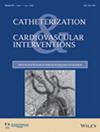Sex differences in transradial access failure in ST segment elevation myocardial infarction
Abstract
Background
Transradial access (TRA) is now the default access site for PPCI, but technically is a more challenging approach mostly due to anatomic challenges connected to the RA.
Aims
To assess the differences according to sex in radial artery (RA) access site characteristics during primary percutaneous coronary intervention (PPCI) for ST segment elevation myocardial infarction (STEMI).
Material and Methods
All 5092 consecutive STEMI patients from our center in the period from March 2011 until December 2017 were examined. The right proximal radial was the “intention-to-treat” access in all patients. Preprocedural RA angiography was performed in all patients. Clinical and procedure characteristics, type of radial anatomy variants, need to use another arterial access sites (the primary endpoint for this study), and procedure time were analyzed by sex. Using logistic regression, we selected predictors of radial crossover. Access site bleeding complications and vascular complications were also recorded.
Results
The STEMI population in this period included 1326 females and 3766 male patients. Females were older (65 ± 11 years) than males (59 ± 11 years, p < 0.0001). Among standard risk factors, hypertension and diabetes mellitus were more common in women and smoking less common. RA anomalies were more frequent in the females (8.8% vs. 6.5%, p < 0.0001), with complex RA loop and tortuous RA twice as frequent in women. Failure of TRA access as the initially chosen site occurred in 4.6% (61) of females versus 2.5% (97) of male STEMI patients (p = 0.0003). The most common subsequent access site was right ulnar access in both groups (57 and 61% respectively). Access site bleeding complications were more common in women 4.4% versus 3.2%, mirrored in hematomas with EASY score III to V. Clinical RA spasm (RAS) was significantly more frequent in females (5.7% vs. 2.2%, p < 0.0001). Multiple regression analysis identified 5 independent predictors for TRA access crossover: previous TRA, anomalous RA, RAS, along with female sex and diabetes.
Conclusion
Female sex is a significant predictor of more complex TRA in STEMI. Understanding sex differences and predictors for TRA crossover will strengthen the use of different procedural modalities that can help in preserving a successful wrist access in female STEMI patients.

 求助内容:
求助内容: 应助结果提醒方式:
应助结果提醒方式:


